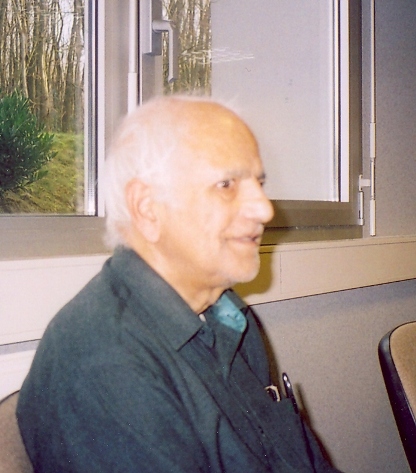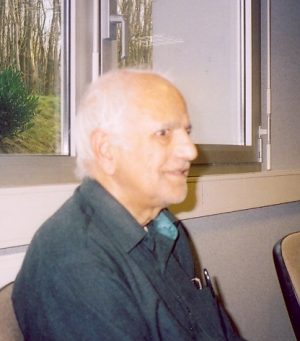Personality out of norm, he was one of the pioneers of the random matrix theory
Madan Lal Mehta, theoretical physicist and former Directeur de Recherche (Senior Research Scientist) in the CNRS, assigned to the Service de physique théorique (SPhT—the theoretical physics department) at the CEA Saclay for most of his career, died on Sunday 10 December 2006 in Udaipur (Rajasthan, India).
Madan Lal Mehta was born in Relmagra, Udaipur on 24th December 1932. In 1956, he obtained his Master of Science degree in mathematics with distinction from the University of Rajasthan, Jaipur. After two years at the Tata Institute for Fundamental Research in Bombay, he arrived in France in November 1958 to join the Service de Physique Mathémathique (now Service de Physique Théorique at the CEA Saclay Nuclear Research Centre.
M.L. Mehta achieved worldwide recognition for his work on random matrices. It was whilst working at Saclay from 1959 to 1961 in the unit directed by Claude Bloch that he revealed the full extent of his talent and mathematical ingenuity. Random matrices had been looked at as early as 1928 by J. Wishart in statistics. In 1951, Eugene P. Wigner hypothesised that the excitation energies of heavy nuclei behave like the eigenvalues of a matrix whose elements are distributed randomly. The experimental and numerical results collected during the 1950s corroborated the hypothesis, but without ever determining the distribution of the eigenvalues. In two articles published in 1960, Madan Lal Mehta and Michel Gaudin obtained the first analytical results and thereby laid the foundation of the orthogonal polynomial method, whose extension made it possible to determine exactly the statistical properties of fundamental sets of random matrices and to study the limit of large matrices. These decisive advances earned Madan Lal Mehta an invitation from E. P. Wigner to work at the Institute for Advanced Studies at Princeton (USA). Before taking up this invitation, Madan Lal Mehta obtained his doctorate in Physical Sciences from the University of Paris in December 1961 under the supervision of Claude Bloch, in the field of low-density nuclear matter. Madan Lal Mehta stayed in Princeton from 1962 to 1963, where he established a lasting collaboration with F.J. Dyson, who had generalised E.P. Wigner's original model. He returned to India to work at the University of Delhi, before another trip to the USA in 1966-1967, when he visited the University of Princeton and the Argonne National Laboratory. In September 1967 he returned to the SPhT at CEA Saclay. He remained there until the end of his career, and returned to his native country in January 2005. Recruited by the CNRS in 1970, he acquired French citizenship in 1971. Madan Lal Mehta's scientific work also took him to Mexico, Australia, Japan, and China. With his natural curiosity and talent for learning languages, he spoke English, French, Russian, Japanese and Chinese, in addition to Hindi and various other Indian languages, to a greater or lesser degree of fluency.
Whilst he tackled various mathematical problems inspired by physics (group theory, knot theory, orthogonal polynomials, etc.), Madan Lal Mehta doggedly devoted most of his scientific activity to random matrices. In addition to M. Gaudin and F.J. Dyson, his main collaborators in this field were P.K. Srivastava, N. Rozenzweig, J. des Cloizeaux, G. Mahoux, A. Pandey, J.-M. Normand and B. Eynard.
The pioneering work of Madan Lal Mehta, particularly through direct contact with J. L. Pichard (CEA Saclay) and O. Bohigas (CNRS University of Orsay), inspired a great many other developments, such as the study of disordered and mesoscopic systems and quantum chaos. The applications of random matrices have been extended to atomic and molecular spectra. New research methods have been developed (perturbation expansions, saddle point methods, replica methods, supersymmetric methods, group theory methods, renormalisation methods, etc.). The ideas of G. 't Hooft in 1974 and the theoretical developments in the 1980s highlighted the profound relationships between random matrices, topological expansions in field theory and random surfaces, opening up new areas of application. Random matrix models are currently used to work on major problems, not only in theoretical physics (disordered systems, mesoscopic systems, quantum chaos, turbulence, quantum chromodynamics in particle physics, and random surfaces, quantum gravitation, string theory, statistical mechanics on random lattices, conformal theories and integrable models, etc.), but also in mathematics (zeros of the zeta function, number theory, algebraic geometry, combinatorics, etc.). The work of Madan Lal Mehta continues to provide a basis for many of these applications and extensions of random matrix theory.
Madan Lal Mehta's clear and concise presentation style is found in his two books: “Random Matrices”, whose first edition was published in 1967 with a third edition in 2004, has become a classic in its field. Less well known, but giving a perfect illustration of the astonishing intuition and algebraic culture of Madan Lal Mehta, is his book on matrices, first published in India in 1977, and then in France in 1988.
A truly unique personality with an outstanding career, an individualist—some might have found Madan Lal Mehta disturbing—but his curiosity, his tenacity, his ingenuousness and his mathematical talent never left him. He is, without any doubt, one of the most memorable figures of the SPhT at Saclay, and he leaves behind him a first-rate body of scientific work in a very active field of research. Madan Lal Mehta had tremendous respect and admiration for his “Professor Claude Bloch, whose support enabled this Indian plant to grow in France”.



